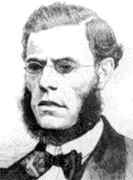Person: Da Silva, Daniel

Daniel da Silva was a Portuguese mathematician and marine officer who made important contibutions in the field of statics and also in number theory.
Mathematical Profile (Excerpt):
- Daniel was baptised in the Lisbon parish of Our Lady of the Martyrs on 19 September 1814.
- We note that da Silva grew up in Portugal at a time when the country suffered civil wars.
- In 1820, when da Silva was six years old, there was an uprising in the country.
- It is certainly the case that da Silva's education took place against a difficult background of tensions and war in the country.
- In 1829, at the age of fifteen, da Silva entered the Portuguese Royal Academy of Midshipmen in Lisbon.
- It was reestablished in Lisbon in 1823, only six years before da Silva began studying there.
- Da Silva showed that he was a very able mathematician and won prizes during his first two years of study for his excellent performance in the Mathematics Courses.
- Da Silva did not qualify under the first two criteria, but could have entered in 1832, after three years of study at the Royal Academy of Midshipmen, because of his excellent performance.
- On 17 August 1835, da Silva applied for leave from the Royal Academy of Marine Guards so that he might attend the Mathematics Course at the University of Coimbra.
- Permission was granted on 4 September 1835 for da Silva to take leave to attend the University of Coimbra but, in November 1835, the new Liberal government proposed to set up an Institute of Physical and Mathematical Sciences in Lisbon.
- Da Silva applied for admission to this new Institute on the grounds that it would be much more convenient to be able to study advanced mathematics courses while in Lisbon.
- Da Silva reverted to his original plan and enrolled in the Faculty of Mathematics at the University of Coimbra.
- Again da Silva was awarded prizes for his achievements in the mathematics courses and was awarded a Bachelor's Degree in Mathematics from the Faculty of Mathematics of the University of Coimbra at the age of twenty-five in 1839.
- After graduating, da Silva applied for a teaching position in the Polytechnic School of Lisbon.
- For the next few years da Silva followed a naval career.
- The Sociedade Escholastico-Philomatica of Lisbon was founded in 1839.
- Da Silva became a substitute lecturer at the Naval School in 1845.
- stated that da Silva had been seriously ill for a long time, so for that reason he had been able to revise neither the preface nor the final part (from page 117 onwards) of his memoir.
- Da Silva does not appear to have been well enough to teach between 1852 and 20 October 1965 when he retired as a lecturer.
- Once retired, da Silva's health improved a little and he taught some courses at the University of Coimbra.
- Most of da Silva's mathematical contributions were made during the years when he was forced to give up teaching because of ill health.
- The second of his Memoirs, however, is a more important work which presents an original approach to problems posed by da Silva himself.
- These results by da Silva did not reach an international audience.
- Over twenty years later, in 1877, Gaston Darboux proved (independently) the same results in his paper Mémoire sur l'équilibre astatique et sur l'effet que peuvent produire des forces de grandeurs et de directions constantes appliquées en des points déterminés d'un corps solide, quand ce corps change de position dans l'espace Ⓣ(Memory on astatic equilibrium and on the effect produced by forces of constant magnitudes and directions applied at determined points of a solid body, when this body changes its position in space).
- When da Silva saw that his priority had not been recognised, he was upset since he knew that the journal in which his paper had appeared was taken by the Paris Academy of Sciences.
- The third of da Silva's three Memoirs was on number theory.
- It was read by da Silva to the Royal Academy of Sciences of Lisbon at the session on 24 March 1852 but illness meant that the published version was incomplete (see the quote about the publisher's note above).
- It was indeed Daniel da Silva who first gave a method to solve systems of linear congruences, an honour which has been unduly attributed to the distinguished English arithmetician Henry Smith, who only in 1861 dealt with this subject, and was also the one who first undertook the general study of congruences.
- Da Silva's health prevented him from doing any serious mathematical research in the years following 1852.
- Da Silva's contribution were recognised with his election to the Grémio Literário (1846), the Academy of Sciences of Lisbon (1850), and the Institute of Coimbra (1855).
- Da Silva died in Oeiras following a severe bout of pneumonia.
- This is Daniel da Silva.
- Daniel da Silva, poet of Mathematics, went to seek in these sciences what they possess that is beautiful ...
Born 16 May 1814, Lisbon, Portugal. Died 6 October 1878, Oeiras, Portugal.
View full biography at MacTutor
Tags relevant for this person:
Astronomy, Origin Portugal
Thank you to the contributors under CC BY-SA 4.0! 

- Github:
-

- non-Github:
- @J-J-O'Connor
- @E-F-Robertson
References
Adapted from other CC BY-SA 4.0 Sources:
- O’Connor, John J; Robertson, Edmund F: MacTutor History of Mathematics Archive
